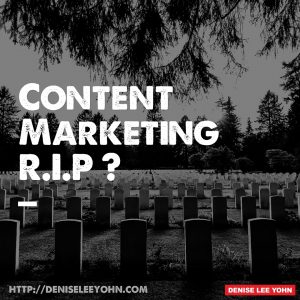Is content marketing is dead? This question was on many people’s minds at the Social Media Marketing World 2016 conference (#SMMW16) a few weeks ago.
Although the vast majority of speakers at the event made it clear that we’re nowhere near the death of content marketing, concern is understandable. More content is being produced now than ever before, but the effectiveness and readership of that content is declining. Consider a few troubling statistics:
Only 30% of B2B marketers say their content marketing is effective, down 8 percentage points from last year — yet 76% say they will produce more content in 2016. (Content Marketing Institute) 50% of B2C marketers say they plan to increase their content marketing budget in 2016 but only 37% report having a documented content marketing strategy. (Content Marketing Institute) Chartbeat, a firm that calculates engagement on websites, has reported no correlation between social shares and people actually reading the content they shared. And according to Sirius Decisions, 60–70% of B2B content created goes unused.
Moreover, in one of the SMMW16 sessions, social media guru Mark Schaefer declared, “The economic value of content that isn’t seen or shared is zero.” A lot of heads nodded in agreement. It seems as if the content in content marketing is being subordinated to the marketing. In other words, what your content is seems to becoming less important than whether or not it is shared.
This troubles me. As someone who relies almost solely on thought-leadership marketing, content is the lifeblood of my efforts to become known, be considered for, and get booked for speaking and consulting engagements — and it’s the primary way I try to cultivate and add value to my business relationships. I invest extraordinary amounts of time and energy producing (what I hope is considered to be) quality content.
I put less emphasis on the marketing and sharing of my content. Of course, I actively promote my content on Twitter and I regularly publish an e-newsletter to an exclusive list of executives. I sometimes post about my content on Facebook or LinkedIn and I curate a Pinterest board. My website and all of my social posts incorporate SEO and include sharing buttons. And I do strategically select contributorships and byline opportunities based on the shares they usually produce — but even in those cases, I usually favor quality over quantity of sharing.
But I don’t advertise my content on Facebook or any other platform; I don’t do any search engine marketing; I don’t use marketing automation or link bait. I’ve resisted publishing breezy free e-books like many of my colleagues do because I’m more committed to providing substantive content than simply generating awareness and followers. I even bristle at the thought of writing headlines or content with the primary objective of making them search-engine friendly.
I’ve understood the consequences of these choices. I don’t have nearly the awareness or following that I would like and I’m working on improving. But I also know I have a limited amount of bandwidth and I’ve always thought it’s better to spend it on the actual content. Said another way, I believe that the economic value of content depends more on the content and less on the marketing. I believe if content has staying power, is compelling to its primary target audience, and can stand up to scrutiny, it has more lasting value than a quick content blast. It’s like the difference between a $1.50 burger from McDonald’s and a $5.00 one from Shake Shack. The former may cost less, but the latter satisfies way more.
Three recent events have confirmed this belief for me:
When Prince died, he left behind a vault full of unreleased music. The vault was just opened by Bremer Trust, who was appointed administrator of the estate following the musician’s death. And inside they discovered enough unreleased music to release a new album every year for the next century. Marketing-focused observers are probably shaking their heads over what Prince missed out on by not releasing this content. Just think of all the accolades, not to mention royalties, he could have accumulated — how many more fans he could have reached, right?! But others understand that Prince was even more private than he was prolific and he deliberately released the content he wanted to release. He, as the content creator, remained the arbiter of what would be shared and the ultimate judge of its value. Chris Anderson and the folks at TED posted the video “TED’s secret to great public speaking.” In it, Chris reveals the one thing that all great TED talks have in common: an idea. He says, “Ideas are the most powerful force shaping human culture.” He goes on to describe how to build an idea, culminating in the final point: Make your idea worth sharing. “Ask yourself ‘who does this idea benefit?,‘” he advises, and be honest with the answer. If the idea only serves you or your organization, then, “It’s not worth sharing. But if you believe the idea…has the potential to change someone else’s perspective for the better or inspire someone to do something differently, then you have the core ingredient to a truly great talk. One that can be a gift to them and to all of us.” Given that TED is all about “ideas worth sharing” and over 2 million TED Talk videos are viewed every day, this reinforces the power of inherently share-worthy content. To fulfill a quick client request, I purchased a small number of copies of my book, What Great Brands Do, from a third-party seller on Amazon. (Like most published authors, I do not get free copies of my books so I have to buy them and I usually buy them through Amazon.) When the books arrived, I discovered that they were from an unauthorized printing done in India. The pages and dust jacket were of lesser quality (thinner, smaller pages, off-color jacket, etc.) To most people, the book probably appeared fine and all the content was accurate, but the book was not up to my or my publisher’s standards, so I returned them and my publisher is investigating the matter so that the remaining copies can be destroyed. While this might mean that fewer people have access to my book, I don’t want a sub-standard book/book experience out there. The book is a reflection of me, after all, and I’m guessing authors who care about their “personal brand” would agree.
This post itself may or may not get shared as much as a shorter, pithier piece with lots of links, images, and quotes. But I wanted — needed — to write it in order to convey the economic value I ascribe to it, to make it a gift to my readers, and to serve as a positive representation of me.
related:
Building Brands by Creating Content (slideshow) Marketing Like It’s 2001 GoPro Shows How to Win by Losing Control
The post the death of content marketing and the economic value of content appeared first on Denise Lee Yohn.













